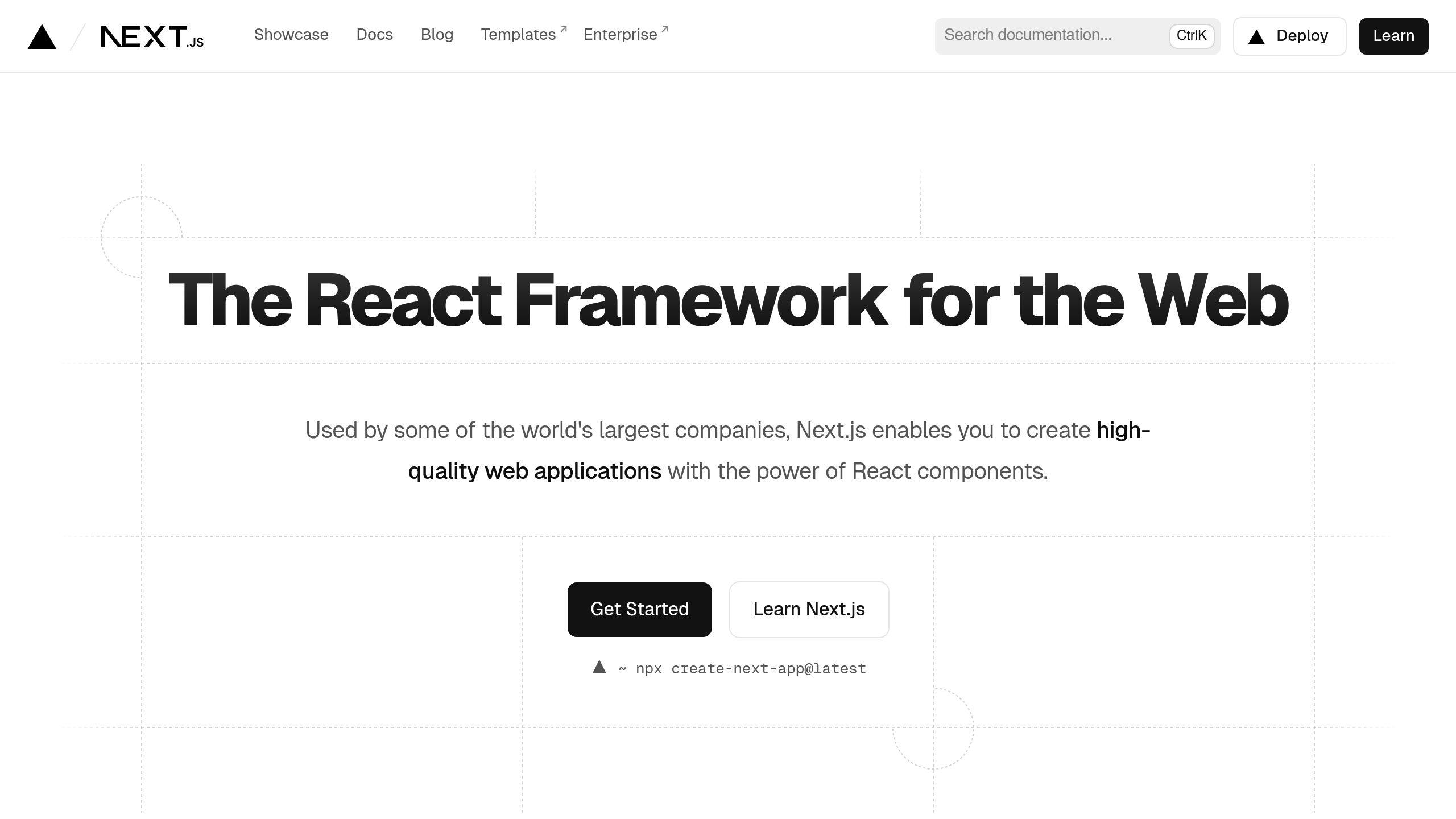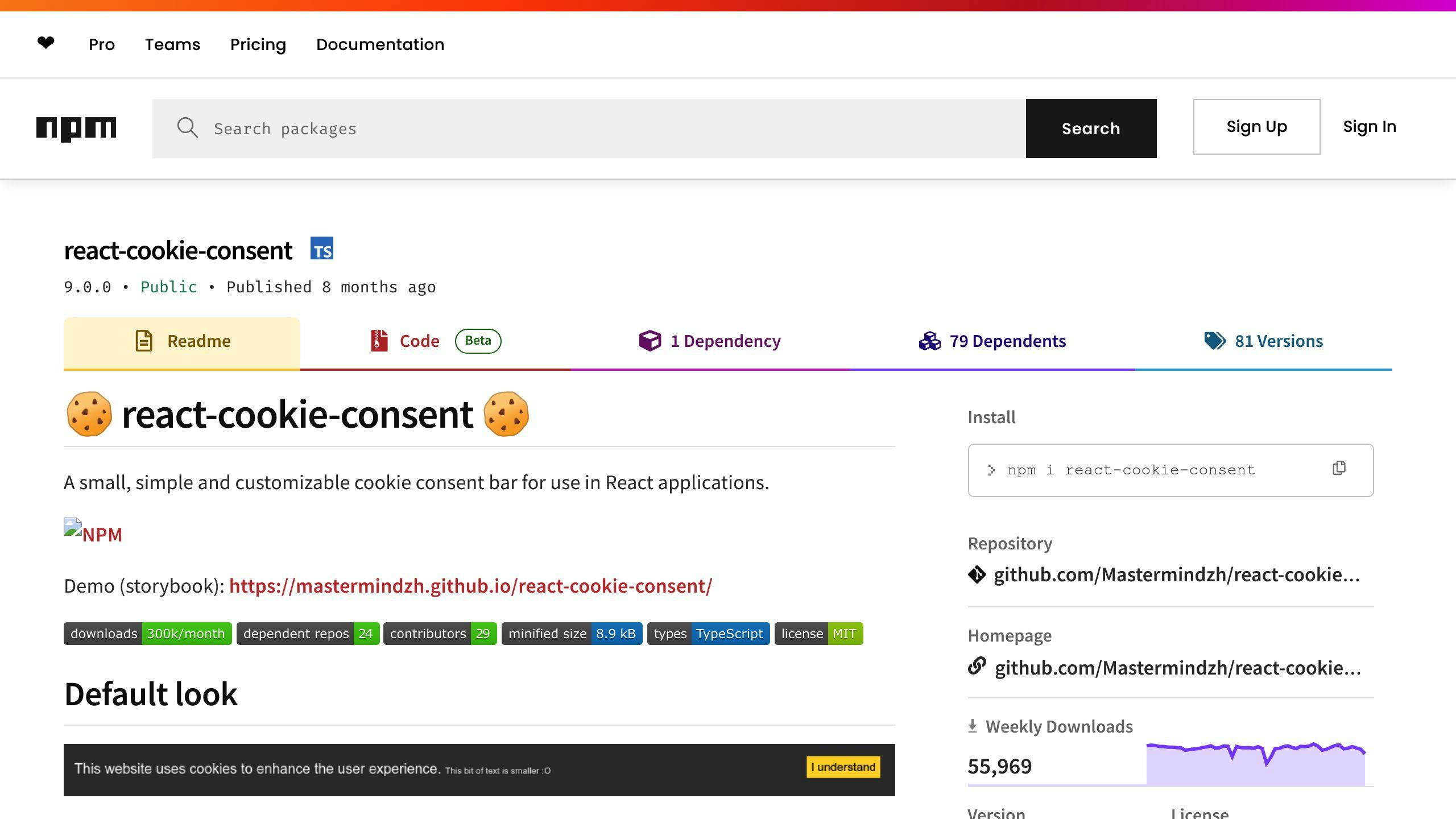
Next.js Cookie Consent Banner: Step-by-Step Guide
Adding a cookie consent banner to your Next.js app is crucial for following data privacy laws like GDPR and CCPA. This guide covers everything you need to implement a user-friendly cookie consent solution:
Why Cookie Consent Matters:
-
User Privacy and Transparency: Shows you care about user privacy, lets users decide if they want to share data, builds trust
-
Legal Compliance: Helps you follow data privacy laws like GDPR and CCPA, avoid fines
-
User Control: Gives users control over their data, improves user experience
Quick Comparison:
This guide does not include a comparison table as it focuses solely on implementing a cookie consent banner in a Next.js application.
Required Tools and Libraries
To add a cookie consent banner to your Next.js app, you'll need a few tools and libraries:
1. react-cookie-consent
This React component makes it easy to display a cookie consent banner. Install it with:
npm install react-cookie-consent
2. js-cookie
This library lets you create, read, and delete cookies. Use it with react-cookie-consent:
npm install js-cookie
3. Tailwind CSS (Optional)
If you're using Tailwind CSS, you can style the cookie banner with its utility classes:
npm install -D tailwindcss postcss autoprefixer
4. Next.js
You'll need Next.js installed. For a new project:
npx create-next-app my-app
With these tools, you can add a cookie consent banner to your Next.js app. This lets users control their data and helps you follow privacy laws.
Set Up Next.js Project

New Project
If you don't have an existing Next.js project, follow these steps:
1. Install Node.js
Make sure you have Node.js version 18 or newer installed. Download it from https://nodejs.org
2. Create a New App
Open your terminal and run:
npx create-next-app@latest my-app
Replace my-app with your desired project name.
3. Navigate to the Project
After installation, navigate to the new project directory:
cd my-app
4. Install Dependencies
Install the required packages:
npm install react-cookie-consent js-cookie
For Tailwind CSS styling, also run:
npm install -D tailwindcss postcss autoprefixer
5. Start the Dev Server
Start the Next.js development server:
npm run dev
Your app should now be running at http://localhost:3000.
Existing Project
If you already have a Next.js project, follow these steps:
1. Navigate to the Project
Open your terminal and navigate to your project directory.
2. Install Dependencies
Install the required packages:
npm install react-cookie-consent js-cookie
For Tailwind CSS styling, also run:
npm install -D tailwindcss postcss autoprefixer
3. Start the Dev Server
Start the Next.js development server:
npm run dev
Your app should now be running at http://localhost:3000.
With your Next.js project set up, you can proceed to create the cookie consent component.
Create Cookie Consent Component
To create the cookie consent component in Next.js, you'll need to track the user's consent preference. You can use React's useState hook or a state management library like React Context API or Redux.
import { useState } from 'react';
const CookieConsent = () => {
const [consent, setConsent] = useState(false);
const handleAccept = () => {
setConsent(true);
// Set cookie or perform other actions
};
const handleDecline = () => {
setConsent(false);
// Remove cookie or perform other actions
};
return (
<div>
{!consent && (
<div>
<p>This website uses cookies to improve your experience.</p>
<button onClick={handleAccept}>Accept</button>
<button onClick={handleDecline}>Decline</button>
</div>
)}
</div>
);
};
In this example, the consent state variable tracks if the user has accepted or declined cookies. The handleAccept and handleDecline functions update the state and perform any necessary actions, such as setting or removing a cookie.
Customize Banner Appearance
You can customize the cookie consent banner's appearance using CSS or a styling library like Tailwind CSS. Here's an example using Tailwind:
<div className="fixed bottom-0 left-0 w-full bg-gray-800 text-white p-4">
<p className="mb-2">This website uses cookies to improve your experience.</p>
<div className="flex justify-end">
<button
className="bg-green-500 hover:bg-green-600 text-white py-2 px-4 rounded mr-2"
onClick={handleAccept}
>
Accept
</button>
<button
className="bg-red-500 hover:bg-red-600 text-white py-2 px-4 rounded"
onClick={handleDecline}
>
Decline
</button>
</div>
</div>
You can add more options or buttons, like "Manage Preferences," which could open a modal or navigate to a separate page where users can customize their cookie preferences.
sbb-itb-1aa3684
Implement Cookie Consent Banner
The cookie consent component should be placed in a top-level layout or wrapper component. This ensures it is shown on all pages of your Next.js app. The consent banner will persist across page navigations and maintain the user's preference.
To keep the user's consent across sessions, store their preference in a cookie or browser storage. When the user revisits the site, check the stored consent value and show or hide the banner accordingly.
Server-Side Cookie Handling
In Next.js, you can read and set cookies on the server-side using the cookies object. This object is available in getServerSideProps, API routes, and middleware functions.
// pages/api/consent.js
import { cookies } from 'next/headers';
export default function handler(req, res) {
// Get the existing cookie value
const consent = cookies().get('consent');
// Set a new cookie value
cookies().set('consent', 'true', { path: '/' });
// Return the cookie value
res.status(200).json({ consent });
}
You can also use cookies in Next.js middleware to perform actions based on the user's consent. For example, blocking third-party scripts or modifying responses.
Client-Side Cookie Handling
On the client-side, use libraries like js-cookie or universal-cookie to manage cookies. These libraries provide a simple API for reading, setting, and removing cookies.
import Cookies from 'js-cookie';
// Get the consent cookie value
const consent = Cookies.get('consent');
// Set the consent cookie value
Cookies.set('consent', 'true', { expires: 365 }); // Expires in 1 year
// Remove the consent cookie
Cookies.remove('consent');
When handling cookies client-side, be careful about storing sensitive data. Cookies are accessible through the browser's developer tools. It's recommended to store only minimal, non-sensitive information in client-side cookies.
Test and Deploy Your Cookie Consent Banner
Cross-Browser Testing
Test your Next.js app with the cookie consent banner on:
-
Google Chrome
-
Mozilla Firefox
-
Safari
-
Microsoft Edge
-
Internet Explorer (if supporting older versions)
Ensure the banner appears and works correctly across all targeted browsers.
Responsive Testing
Test the banner's responsiveness on:
-
Desktop computers
-
Laptops
-
Tablets
-
Smartphones (iOS and Android)
Verify that the banner adapts well to different screen sizes and orientations.
User Testing
Get real users or testers to interact with the cookie consent banner. Gather feedback on:
-
Clarity
-
Usability
-
Overall user experience
Identify and fix any issues or areas for improvement.
Staging Environment
Set up a staging environment similar to production. Test the app with the cookie consent banner in this staging environment to catch any potential deployment or server configuration issues.
Production Deployment
Once testing is complete, deploy your Next.js app with the cookie consent banner to your production environment. Ensure the deployment process doesn't introduce new issues.
Monitoring and Maintenance
After deployment, monitor the app's performance and user feedback. Be prepared to address any issues or make updates to the cookie consent banner as needed.
Final Thoughts
Adding a cookie consent banner to your Next.js app is crucial for following data privacy laws like GDPR and CCPA. This step-by-step guide covered how to set up the project, create the consent component, handle cookies on the server and client sides, and more.
As privacy laws change, it's important to keep your cookie consent solution up-to-date. Regularly review it to ensure it meets the latest requirements and provides a clear, user-friendly experience.
Getting proper consent is not just a legal obligation but also builds trust with your users. By clearly explaining how you handle their data and giving them control over their privacy preferences, you show respect for their rights and foster a positive relationship.
While this guide covers the basics, there may be additional considerations based on your specific use case, such as integrating with third-party services or implementing advanced consent management features. Continuously monitor and improve your cookie consent solution to deliver a compliant experience across all platforms and devices.
Key Takeaways
-
Cookie consent banners are essential for legal compliance and user trust
-
Follow this guide to implement a consent solution in your Next.js app
-
Stay updated on changing privacy laws and requirements
-
Regularly review and enhance your cookie consent implementation
-
Provide transparency and user control over data handling
| Consideration | Importance |
|---|---|
| Legal Compliance | Mandatory to follow data privacy laws |
| User Trust | Crucial for building positive relationships |
| Transparency | Clearly explain data handling practices |
| User Control | Allow users to manage privacy preferences |
| Continuous Improvement | Regularly update and enhance the solution |
Additional Resources
For more information on adding a cookie consent banner to your Next.js app, here are some helpful resources:
Official Next.js Documentation
The Next.js Documentation covers how to customize the Document component to inject scripts and metadata.
react-cookie-consent Library

react-cookie-consent is a popular open-source library for adding a cookie consent banner to React apps.
Third-Party Consent Management Platforms
You may also want to explore third-party consent management solutions like:
| Platform | Description |
|---|---|
| Cookiebot | Comprehensive cookie consent management platform with advanced features. |
| OneTrust | Offers robust tools for compliance, consent tracking, and user preferences. |
| Termly | Provides cookie consent management and privacy policy solutions. |
| CookieYes | Cookie consent management platform with customizable banners and preferences. |
| Osano | Offers cookie consent management, data mapping, and privacy compliance tools. |
These platforms provide additional features and tools for managing cookie consent and user preferences.